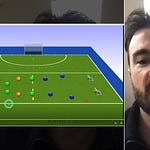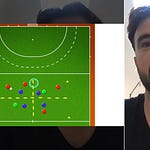In this comprehensive workshop, we delve into the art of dynamic attacking in field hockey, guided by Robert Noall. With a focus on skill development and tactical execution, this session provides coaches with the tools to enhance their team's attacking strategies and overall performance.
Introduction to Dynamic Attacking
Dynamic attacking is an essential aspect of field hockey that significantly enhances a team's offensive capabilities. It involves quick, fluid movements and strategic positioning to create scoring opportunities. This approach not only puts pressure on the opposing defense but also allows players to exploit spaces effectively. By focusing on dynamic attacking, coaches can cultivate a more versatile and unpredictable style of play.
The Importance of Movement
In dynamic attacking, movement is key. Players must be in constant motion, not only with the ball but also without it. This movement creates options and forces defenders to make decisions, often leading to mistakes. When players are stationary, they become easier to defend against. Therefore, incorporating drills that emphasize movement into training sessions is crucial for developing a dynamic attacking strategy.
Key Concepts of Dynamic Attacking
Creating Space: Players should learn to create space for themselves and their teammates. This can be achieved through effective leading and movement off the ball.
Dynamic Receiving: The ability to receive the ball while in motion is vital. This skill allows players to maintain momentum and quickly transition into attacking plays.
Prescanning: Before receiving the ball, players should scan the field to identify available options. This awareness allows for quicker decision-making and more effective attacking plays.
Second Stage Running: This refers to the movement players make after their initial run. By continuing to move, they can create additional opportunities and space for their teammates.
Understanding Player Movements
To fully grasp dynamic attacking, it's important to analyze the movements of players both on and off the ball. Each player has a role in creating opportunities, and understanding these movements can lead to more effective training methods.
Types of Movements
Leading: Players must lead into space to receive the ball. Effective leading creates passing lanes and draws defenders out of position.
Changing Direction: Players should practice changing direction quickly after receiving the ball. This keeps defenders guessing and allows for more dynamic attacks.
Double Movements: Players can create confusion for defenders by making multiple movements in quick succession. This can open up space for themselves or their teammates.
Practicing Movement Drills
Incorporate drills that focus on movement into training sessions. For example, set up small-sided games that require players to constantly move and reposition themselves based on the ball's location. This will help them understand the importance of movement in dynamic attacking.
Analyzing Game Footage
Reviewing game footage is a valuable tool for coaches and players alike. It provides insight into the effectiveness of dynamic attacking strategies and highlights areas for improvement.
Identifying Patterns
When analyzing footage, look for patterns in the team's attacking plays. Are players making effective leads? Are they receiving the ball dynamically? Identifying these patterns can help coaches tailor their training sessions to address specific issues.
Learning from Mistakes
Game footage also allows teams to learn from mistakes. By reviewing plays that didn't result in scoring opportunities, players can understand what went wrong and how to adjust their movements in future games.
Key Skills for Dynamic Attacking
To implement a successful dynamic attacking strategy, players must develop specific skills that enhance their effectiveness on the field.
Essential Skills
Listen to this episode with a 7-day free trial
Subscribe to The Hockey Site to listen to this post and get 7 days of free access to the full post archives.













